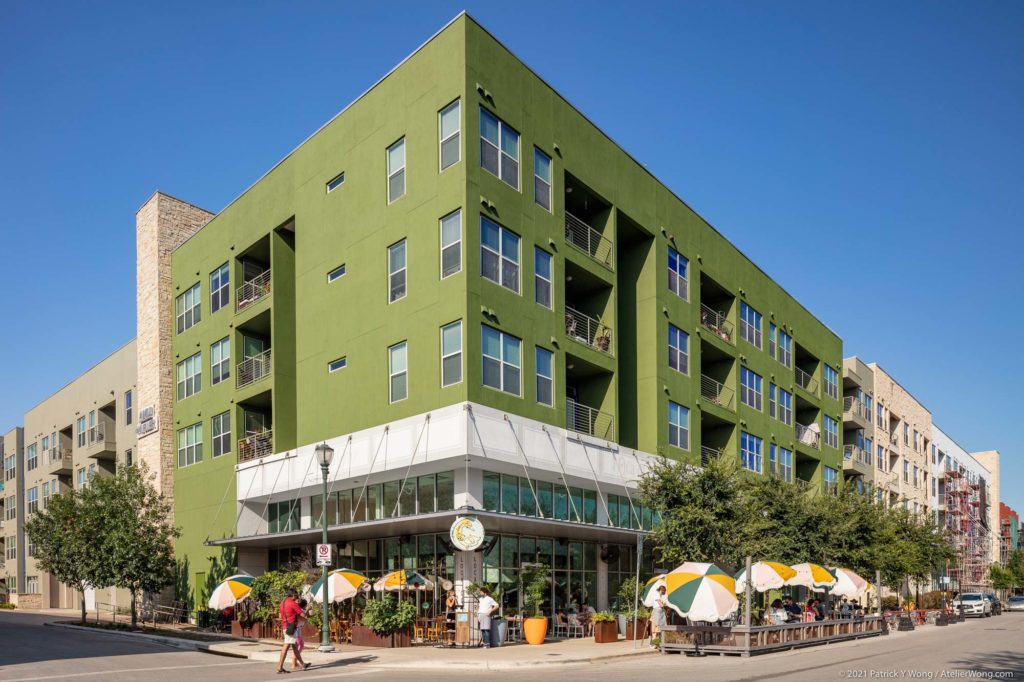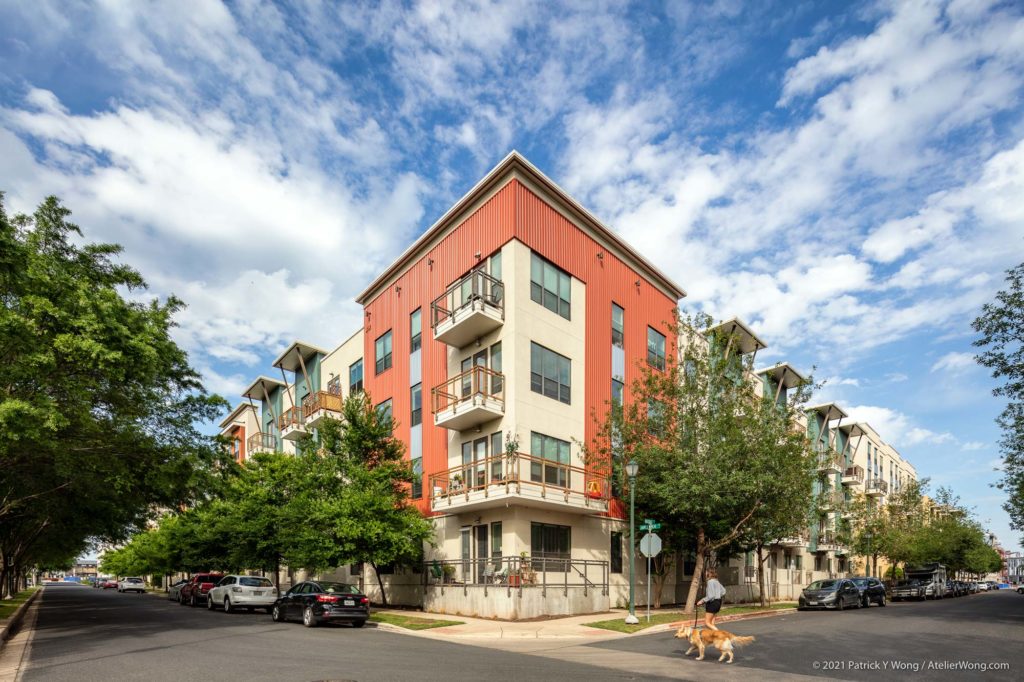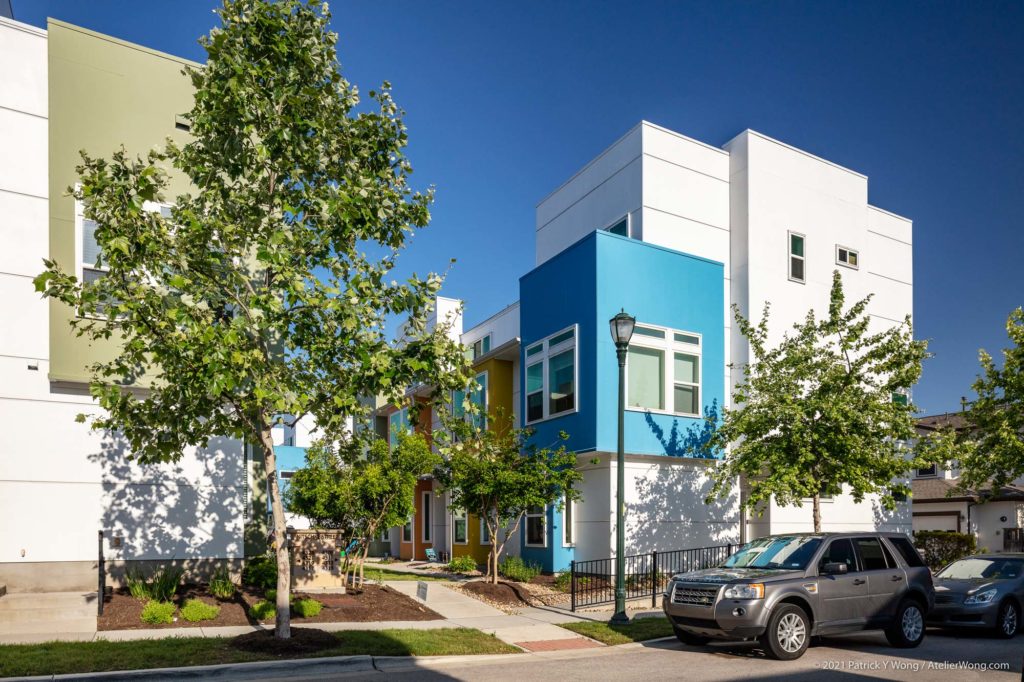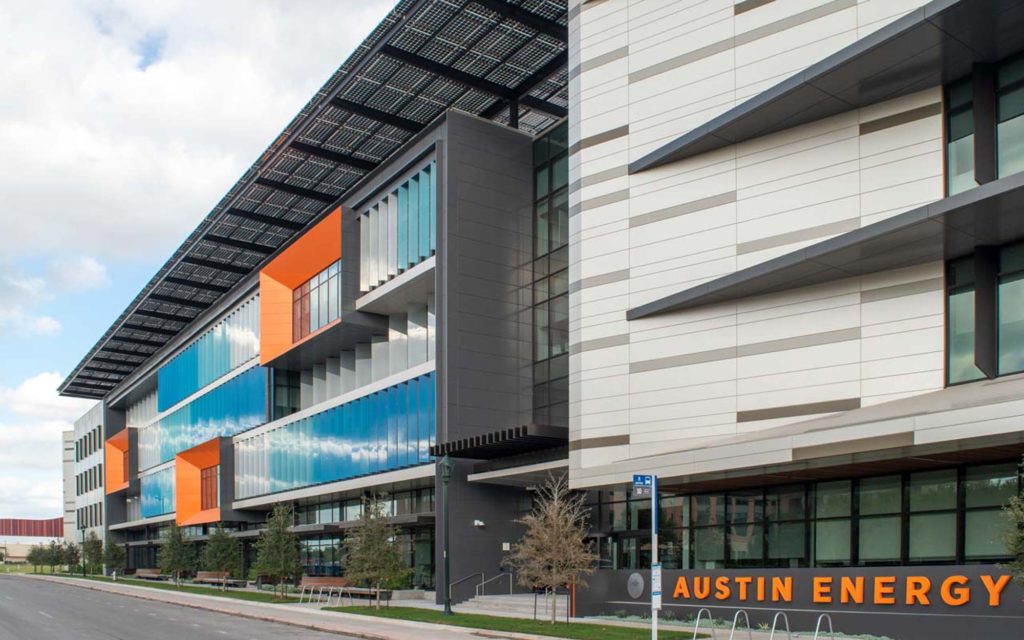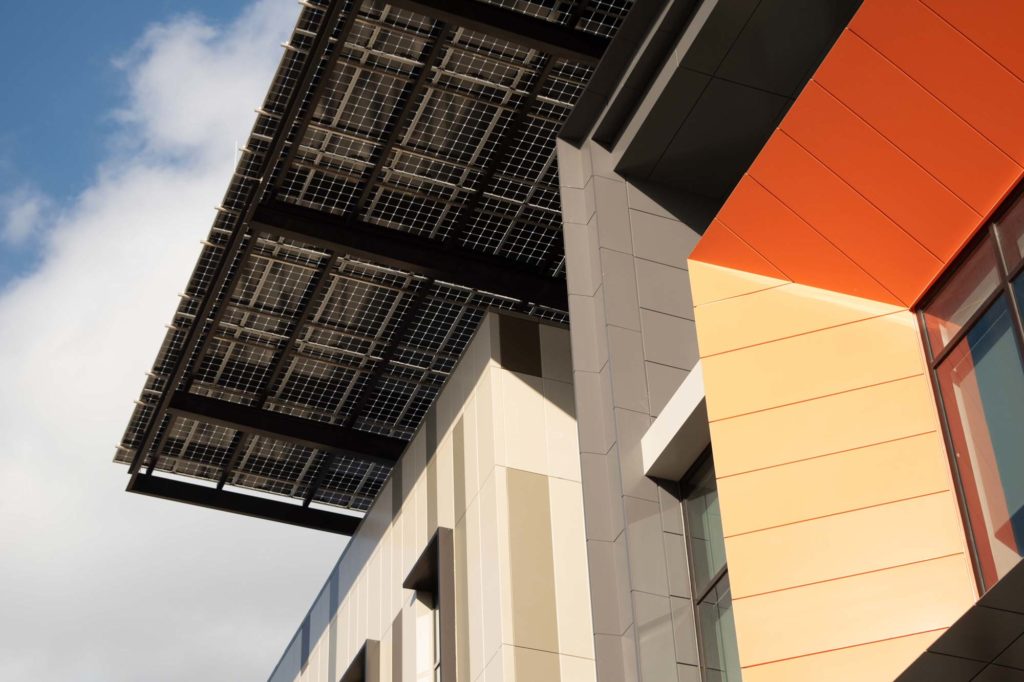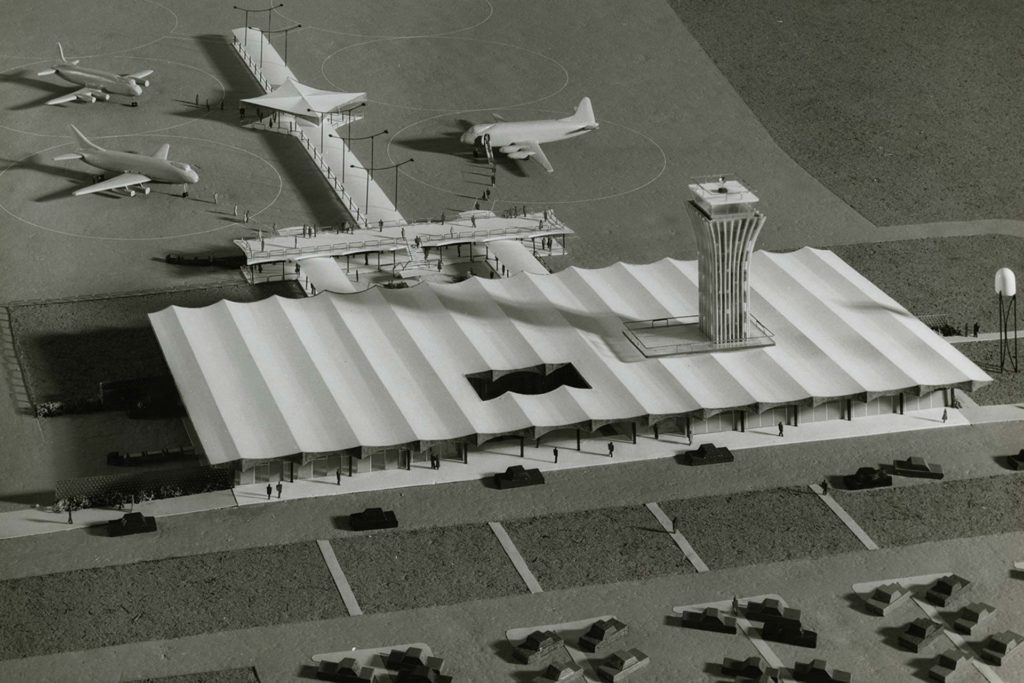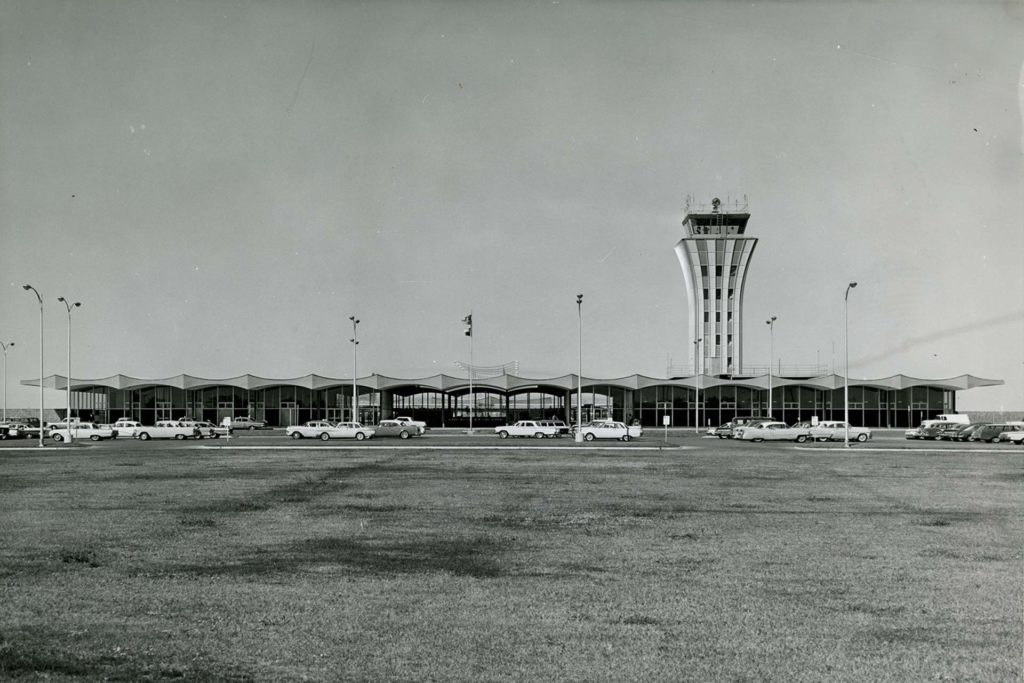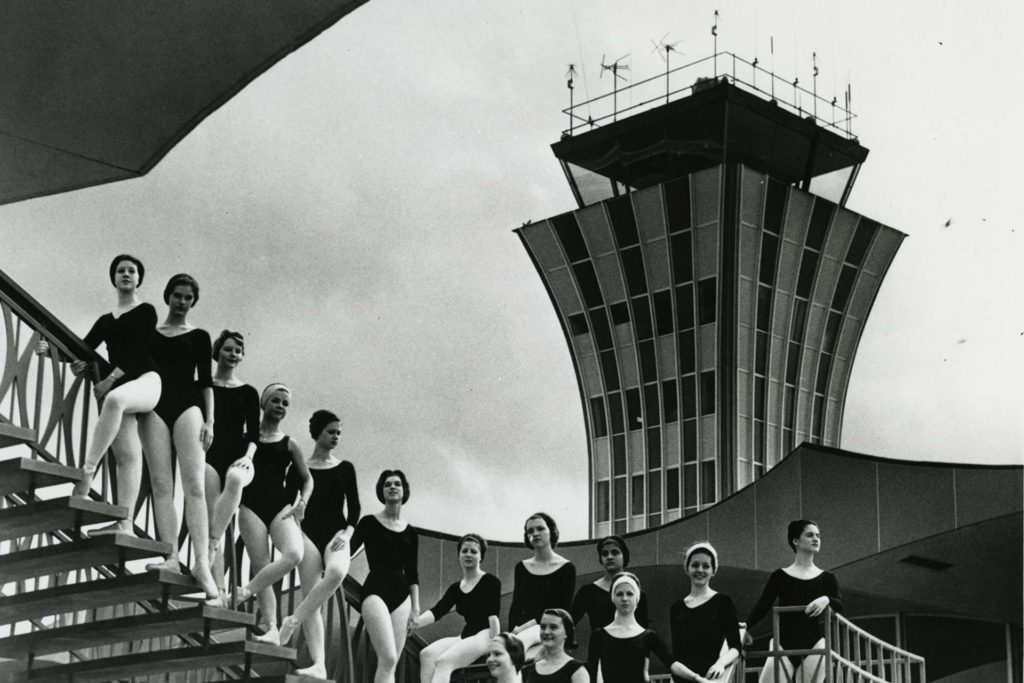- Built:
- 1930 (original airport)
- Alterations:
- 2007–ongoing (Mueller Development)
Description
Mueller is a public-private partnership between the City of Austin and Catellus Development Corporation to redevelop the former Robert Mueller Municipal Airport. As of 2021 there are 2.2 million square feet of commercial space (43% built-out) and 3,636 residential units (44% built-out). This development is host to a retail center, offices, a hospital, entertainment, a performing arts center, movie studios, and several parks.
Placemaking
In the 1920s, Lt. Claire Chennault developed the Robert Mueller Municipal Airport four miles northeast of downtown Austin at the Matthews farm tract (Lt. Chennault later rose to the rank of 3-Star General and was the leader of the famous Flying Tigers fighter squadron in World War II). The airport was officially dedicated on October 14, 1930, and airline flights began in 1936.
A now-demolished mid-century modern terminal opened in 1961 with a dedication ceremony attended by Vice President Lyndon Johnson and Mayor Lester Palmer. This terminal featured a scalloped, thin-shell concrete roof faced in two-toned blue porcelain that attracted architects from as far away as South America curious to replicate its form and construction techniques. Inside, the Driskill Coffee Shop and Restaurant was run by the owners of the landmark downtown Driskill Hotel. The iconic, flared concrete-frame control tower remains and was renovated in 2007.
In 1984, the redevelopment of Mueller from airport to mixed-use sustainable neighborhood began with the Citizens for Airport Relocation (CARE) and a neighborhood planning process driven by the Mueller Neighborhood Coalition (MNC), as well as the support of AIA Austin and The University of Texas.
A significant community-driven New Urbanist infill development site, Mueller is conceived to be a model for green development that provides a framework for healthy, connected, and affordable living. A variety of activities are hosted in a neighborhood of compact, pedestrian-oriented, tree-lined streets. Collective social recreation, cultural spaces, and a local farmer’s market all promote wellbeing on a neighborhood scale. Alternative renewable energy sources, efficient district heating and cooling, reclaimed and reduced water usage, and smart solid waste management ensure that Mueller has a light environmental footprint.
Mueller is significant for Austin. While rich in history, it is also an important guidepost to Austin’s sustainable future. It proves that responsible, enjoyable, and affordable development can occur in Austin, and it will be held as the local paradigm for green building for years to come. It proves that quality of life is no longer a luxury but a design imperative as we strive to create resilient, healthy urban patterns to support a future Austin that is uniquely laid back, yet progressively metropolitan. – Riley Triggs, AIA
Sustainability Highlights
- Envisioned as a sustainable community from the beginning, Mueller has achieved LEED ND (Neighborhood Development) certification. As of 2021, Mueller has: 53 rated commercial projects of 2.2M square feet; 1623 AEGB (Austin Energy Green Building) rated homes; 2,013 multifamily units; and 25% residential participation in an affordable housing program.
- The development approaches sustainability holistically with many green features including: solar panels and photovoltaic outdoor art; native vegetation and relocated trees; a district-scale stormwater management system; reclaimed water use; diversion of more than 63,000 tons of construction and demolition debris; and 83,505 tons of carbon from landfills as of 2016.
- Austin Energy’s Mueller Energy Center provides: chilled water cooling for 994,468 square feet of commercial buildings; steam for sterilization and onsite electric production to Seton’s Dell Children’s Medical Center; and 232 kW of solar energy capacity on AEGB commercial rated buildings.
- Reclaimed water usage provides: a savings of 24.7M gallons in irrigation; and indoor flushing fixtures at Mueller Central, Mueller Diamond, Frost Bank, AISD Performing Arts Center, and the H-E-B grocery store.
Points of Interest
Austin Energy Headquarters
4815 Mueller Boulevard
Designed for LEED Platinum (U.S. Green Building Council), AEGB 5-Star (Austin Energy Green Building), and WELL Building Certification
Style: Contemporary
Built: 2021
Architect: ELS Architecture; Page Southerland Page, Inc.
Landscape Architect: Coleman & Associates
Builder: Harvey-Cleary
Austin Energy Headquarters is a four-story 275,000-square-foot office building that houses approximately 1,000 employees. Shaded by a 647.4 kW-dc solar array, the building is a model for green building and maximizes connections to the outdoors, daylight, circulation, and social interaction for a holistic approach to occupant wellness. A central social stair allows for chance interactions and promotes healthy movement for staff and visitors. A shaded terrace and courtyard provide outdoor gathering spaces for various activities.
Branch Park Pavilion
2006 Philomena Street
AEGB 3-Star
Style: Contemporary
Built: 2021
Architect: Lawrence Group
Builder: Engen Contracting, Inc.
Mary Elizabeth Branch Park
2006 Philomena Street
SITES Certified (The Sustainable SITES Initiative)
Built: 2019
Landscape Architect: Design Workshop
Builder: Rupert Landscape
The 3.5-acre Mary Elizabeth Branch Park is designed to accommodate multi-generational use with a creative children’s playground, dog park, sand volleyball courts, an interactive waterscape, shaded picnic space, and a large open lawn. A rain garden treats stormwater runoff and provides a garden setting for seating. The Branch Pavilion connects directly to the park with large openings making it an indoor/outdoor space for a farmer’s market, celebrations, and community events.
Austin Studios
1901 E 51st Street
LEED Certified
Style: Contemporary (Adaptive Reuse; former National Guard Armory)
Built: 2019
Architect: Gensler
Builder: Swinerton
AISD Performing Arts Center
1500 Barbara Jordan Boulevard
AEGB 5-Star
Style: Contemporary
Built: 2015
Architect: Miró Rivera Architects; Pfluger Associates Architects
Builder: American Constructors, Inc.
Seton’s Dell Children’s Medical Center and South Tower addition
4900 Mueller Boulevard
First LEED Platinum hospital in North America, AEGB 5-Star
Style: Contemporary
Built: 2007
Architect: Karlsberger Architecture (base building); Polkinghorn Group Architects (South Tower)
Landscape Architect: TBG Partners
Builder: White Construction (base building); The Beck Group (South Tower)
Mueller Control Tower (remaining) and Terminal (demolished)
3900 block of Berkman Drive
1959 Progressive Architecture Awards
Style: Mid Century Modern
Built: 1961
Architect: Fehr and Granger
Atelier Wong Photography (1-5); Riley Triggs, AIA (6-8); Austin History Center (9-11)
